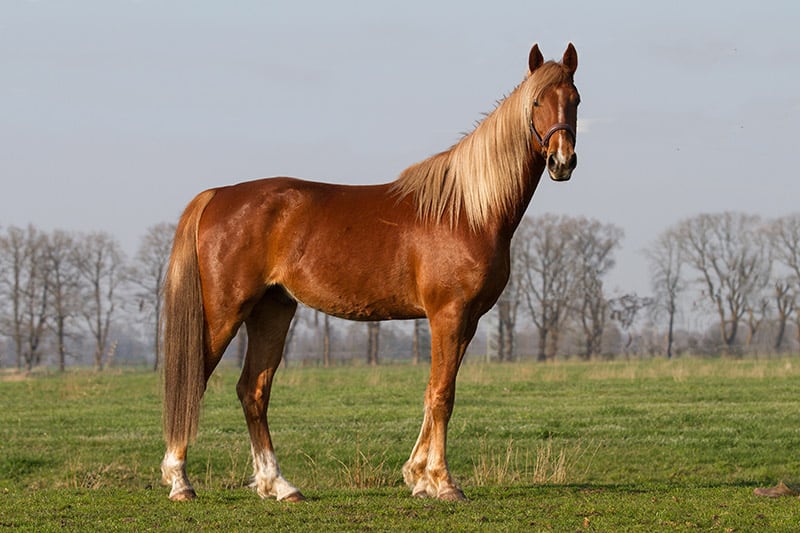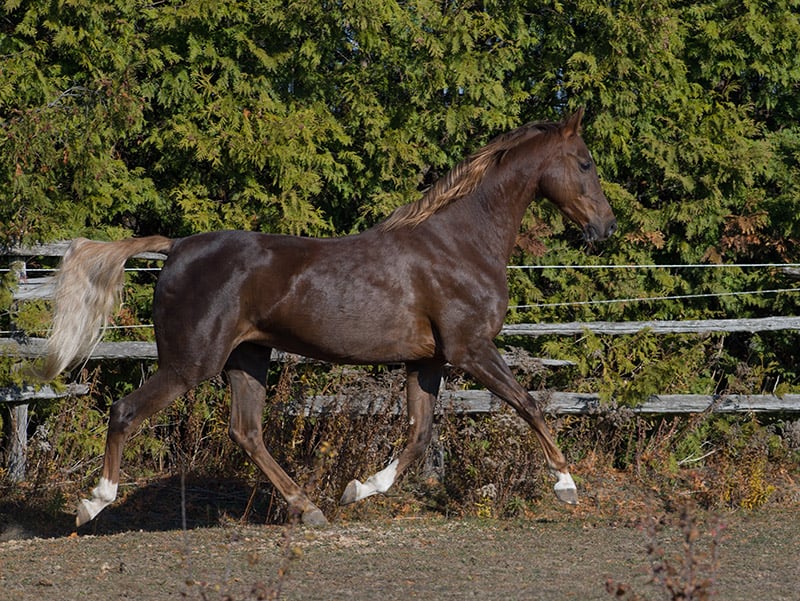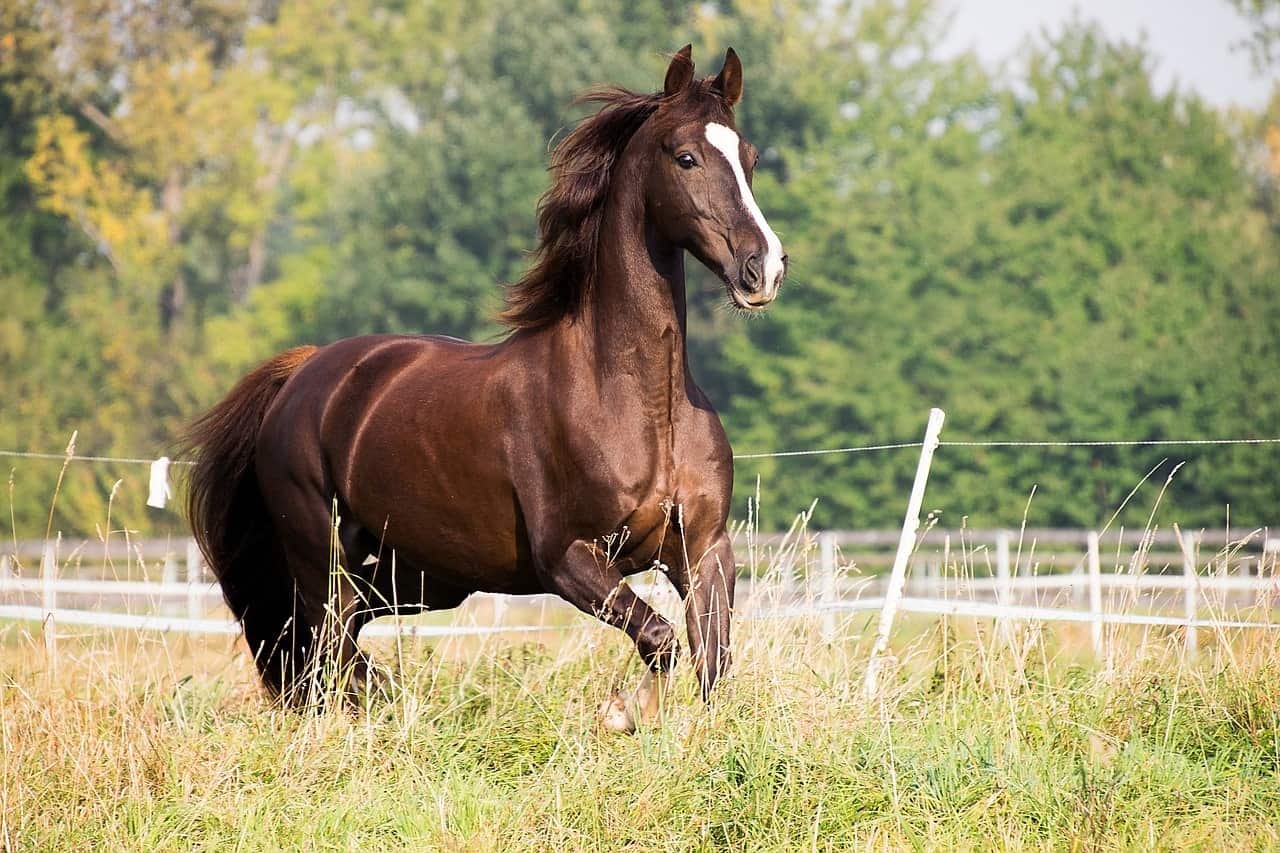The American Saddlebred was “the American horse” during the early history of the United States!
The trotting breeds went out of fashion in England in the 17th Century when Thoroughbred racing became popular. So these breeds found their way to North America where their gaits were preserved and refined. The classes for gaited horses remained the central feature of American horse shows through the early 20th Century. In 1891, the American Saddlebred Horse Association was founded in Louisville, Kentucky. This was the first such organization for an American breed of horse.
The American Saddlebred is known for its flashy appearance and five beautiful high-stepping gait. The American Saddlebred horses are still known today as being the ultimate show horse. With a long history and development in both Canada and the United States, the American Saddlebred could be considered as one the native American horses.
Scientific Classification
| Kingdom: | Animalia |
| Phylum: | Chordata |
| Class: | Mammalia |
| Order: | Perissodactyla |
| Family: | Equidae |
| Genus: | Equus |
| Species: | caballus |
Horse Breeds
The American Saddlebred is a light horse breed, and one of the gaited horses. Light horse breeds generally weigh under 1,500 pounds. They are typically used as riding horses for leisure and trail riding. Being agile and swift, many are also used on the racetrack, in the show ring, and for work on the ranch.
Light horses are grouped in a couple of different ways, one being the continent or country where they originated from. They are also grouped according to training, classified as either a stock type, hunter type, saddle type, or ‘other’. A body type is generally attributed to each class, with the ‘other’ classification being a bit of an odd ball. It includes those that are color breeds or those that may fit a body type of one of the training classes, but not be used for that type of training. The ‘other’ types can also include those that may fit into more than one of the type groups.
The horse class the American Saddlebred fits into the saddle type class and is recognized for its high stepping gait.

Horse Backgrounds
The American Saddlebred can trace its roots back to the natural-gaited Galloway and Hobbie horses brought to North America from Great Britain. These trotting breeds had gone out of fashion in England in the 17th Century when Thoroughbred racing became established and began to outshine sulky racing, for which trotting horses were bred. These breeds found their way to the United States where their gaits were preserved and refined.
Through selective breeding, the Narragansett Pacer was developed along the eastern seaboard and the Canadian Pacer in eastern Canada. These were crossed with Thoroughbreds imported in the early 18th Century. By the Revolutionary War, these horses called simply “the American horse” became a recognized type. These horses, mostly bred in Kentucky, began to be dubbed the Kentucky Saddler and continued to be crossed with Thoroughbreds and Morgans to improve and refine the breed.
During the Civil War, most of the high-ranking officers rode Saddler mounts, including Generals Lee, Grant, Sherman, and ‘Stonewall’ Jackson. At the first national horse show at the St. Louis Fair in 1856, Saddlebreds dominated the competition and became popular for their beauty and utility.
The gaited horse classes remained the central feature of American horse shows through the early 20th Century. In 1891, the American Saddlebred Horse Association was founded in Louisville, Kentucky, and was the first such organization for an American breed of horse. The American Saddlebreds could be placed as one of the native American horses and it is still known today as being the ultimate show horse.
Description
The American Saddlebred horses typically stand between 15 and 16 hands high and come in a wide variety of colors. They have a small, elegant head with wide-set eyes set on a long neck that is arched and well-flexed at the pole. They have well-defined withers and a short back and flat croup. The legs are long and Saddlebreds are trained to stand with their hind legs camped out behind. The feet are grown unnaturally long and shod with heavy shoes to enhance the high-stepping action for the show ring, and the high-set tail is allowed to grow so long that it drags on the ground.
The most distinguishing feature of the American Saddlebred is its high-stepping gaits. The Saddlebred can be either three-gaited or five-gaited. It naturally performs the walk, trot, and canter with some high-stepping action, but it can then be trained to perform these gaits with increased action and the additional ‘slow gait’ and ‘rack’.
- Three-gait: The three-gaited variety performs only the walk, trot, and canter with high-stepping action.
- Five-gait: The five-gaited Saddlebreds are trained to perform the additional slow gait and rack.
- Slow-gait: The footfalls of the slow gait and rack begin with the lateral front and hind feet starting almost together, but the hind foot contacts the ground slightly before its lateral forefoot. The slow gait is a highly-collected gait with each of the four feet striking the ground separately. It is executed slowly but with distinct precision, full of style and brilliant restraint.
- Rack: In the rack, each foot meets the ground at equal, separate intervals. It gives a smooth ride and can achieve speeds up to 38 mph!
When they are moving, these gaited horses have their hind end tucked underneath and their withers and shoulders high, with the front legs kicking out in front. It is an amazing sight to see!

Horse Care and Feeding
Keeping an American Saddlebred show-ready is no easy task. They must be groomed regularly and their coats clipped for an even look. Their long tails can be kept in a tail bag for protection.
Horse Training and Activities
Saddlebreds are extremely flashy show horses with their fancy gaits and long, flowing tails. They carry themselves with an attitude – alert, with an arched neck, head up and ears forward, every movement saying, “Look at me!” Saddlebreds compete at open shows in saddleseat, harness, pleasure, or gaited horse classes. At Saddlebred shows, they compete in five primary divisions: five-gaited, three-gaited, fine harness, park, and pleasure. In the show ring, they are judged on the quality of their gaits, manners, presence, and total conformation. The Saddlebred is also used widely for trail and pleasure riding, as well as for cutting cattle. They are also popular parade horses.
Common Health Problems
Saddlebreds may be prone to stifle and hock lamenesses due to the way they carry their back ends when they move. They also may be prone to ringbone and sidebone in their front feet, which are both characterized by the formation of calcium deposits, due to the increased concussion caused by the high-stepping action.

Availability
The American Saddlebred is available throughout the United States, but are bred mostly in the southern states of Kentucky and Virginia. The prices vary depending on the level of training and show experience. A foal may be purchased at around $500 at auction, whereas an accomplished show horse may cost hundreds of thousands.
Featured Image Credit: RebeccasPictures, Pixabay
